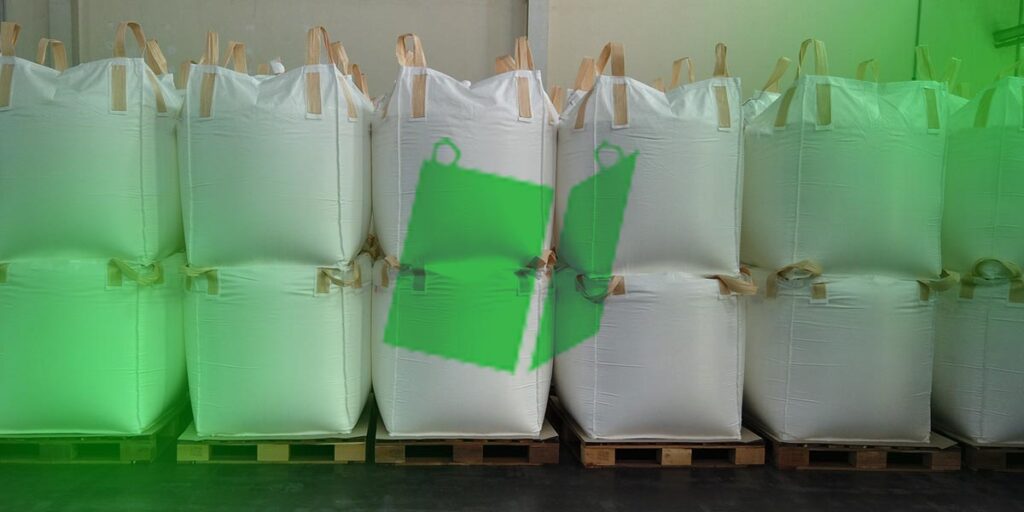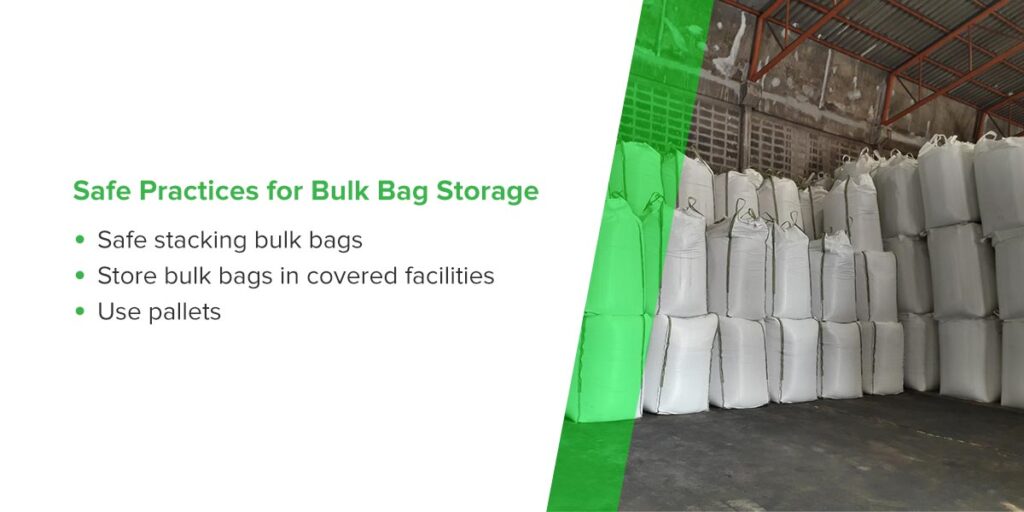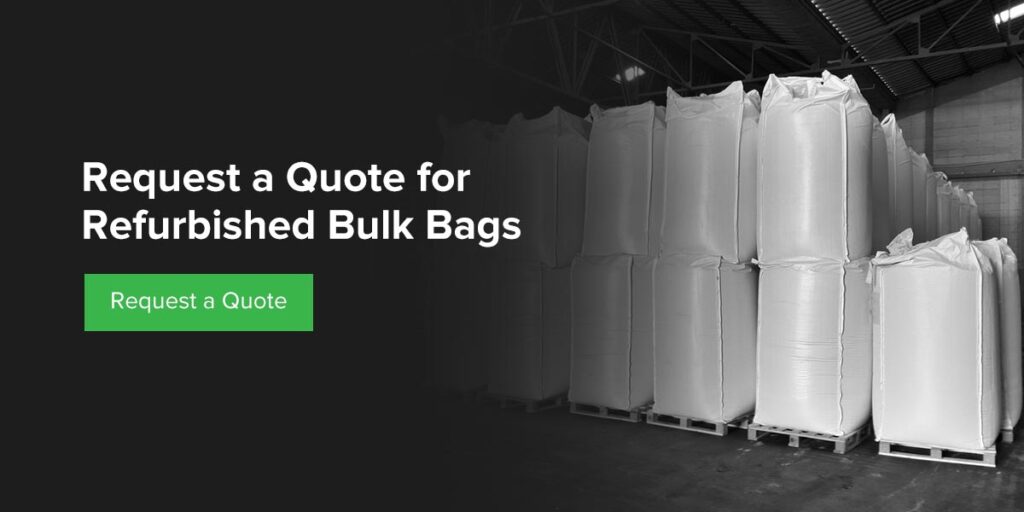Safety Tips for Handling and Unloading Bulk Bags
Flexible intermediate bulk containers (FIBCs) are widely used for product storage and shipping. They’re available in various sizes and materials to safely accommodate a range of products. While bulk bags offer convenience and benefits, they also have their own set of safety risks. Staying safe when using bulk bags is critical, so keep these safety tips in mind when handling FIBCs.
How to Safely Fill Bulk Bags
Bulk bag safety begins when you fill them. Knowing how to fill bulk bags properly helps ensure they’re handled safely from the very beginning. Here are a few tips for safely filling bulk bags.
Ensure the Bag Is Approved for the Product
Bulk bags are used for storing and transporting various materials and products, ranging from hazardous materials to wheat and grains. Using the right bag for the product being handled is crucial. Appropriate bags help ensure the product is adequately stored without running the risk of damaging the bag or potentially causing harm to anyone handling the bags.
Fill Bags in an Appropriate Environment
Filling bags in an appropriate environment helps prevent avoidable injuries. For example, if you’re filling explosive or flammable materials into a bulk bag, they can create? static electricity. When this electricity is discharged in an inappropriate environment, anyone around the bag could sustain serious, deadly injuries. The best practice is to fill and empty bags in an appropriate environment.
Ensure the Bag Is Secure
Before filling a bulk bag, ensure it’s fully secured. The discharge spout should be closed properly, and the bag should be held open to prevent it from falling as it’s filled. It’s also important to fill the bag evenly with the product to ensure stability and prevent the bag from tilting over and putting you and your employees in a risky situation.
Avoid Exceeding the Rated Capacity or Safe Working Load (SWL)
According to FIBC safe handling guidelines outlined by the Flexible Intermediate Bulk Container Association (FIBCA), you should always stay under a bag’s SWL or rated capacity. If the capacity is exceeded, the chances of bag failure increase significantly.
Close Bags as Instructed
Proper bag closure is crucial to preventing products from leaking at any point during handling. This is especially important when storing or transporting hazardous materials, as leaks can create dangerous situations. Be sure to follow the manufacturer’s instructions for closing the bag.
How to Move and Transport Bulk Bags
Bulk bags can be moved and transported around the world, which is one of the many reasons they’re so commonly used. Here are some tips for moving and transporting bulk bags:
- Ensure devices are designed for FIBCs: Before using forklifts or other machinery for moving bulk bags, ensure they’re properly equipped or designed to do so. Check for safety latches and weight capacities to ensure the equipment can safely lift the bags when full. Any equipment used should also be free of sharp edges to prevent the bag’s loops from being torn.
- One hook per loop: The lift loops on bulk bags are intended to be used collectively to ensure the full weight is adequately supported. You should always use every loop and one hook per loop rather than gathering them on one hook, as doing so increases the risk of a loop tearing and dropping the bag from the suspended height.
- Keep loops vertical: If you only have one hook, other lifting devices like slings should be used to keep the loops vertical. If they’re lifted laterally, the force could damage the bag.
- Keep clear of suspended bags: No one should ever stand under or near a suspended bulk bag. Keep all employees clear of the area when bags are suspended to prevent any injuries or death in case a bag falls.
- Secure bags during transport: Be sure to tie down FIBCs during transport if they are at risk of moving or sliding around. Secured bags are much safer to transport and there’s less risk of a bag breaking open.
Safe Practices for Bulk Bag Storage
To keep products in good condition and stored safely, here are some tips for bulk bag storage:
- Safe stacking bulk bags: Some bulk bags aren’t intended to be stacked. If your bags are designed for stacking, they should either be stacked in a pyramid or between two walls for support.
- Store bulk bags in covered facilities: It’s best to store FIBCs in covered warehouses or facilities to protect the bags from exposure to the sun, moisture and inclement weather.
- Use pallets: To keep bulk bags off the ground, store them on pallets — pallets can also make transporting bags easier. Just be sure they’re an appropriate size and free of nails, sharp objects or edges that could damage the bags.
Safety Tips for Unloading Bulk Bags
Unloading bulk bags can be hazardous if you don’t know to unload a bulk bag properly. If you or your employees are unloading or discharging products from the bags, be sure to keep these safety tips in mind:
- Control the dust: If the materials in the bags are dry, they’ll likely create significant amounts of dust when they’re being unloaded. This can cause a fire hazard and pollute the air, so be sure to have methods of controlling the dust, like a ventilation system.
- Control static: When materials like powders flow out of a bulk bag at high speeds, they emit a static that can spark dust and explode under the right conditions. To help mitigate the risk of static, ground the frame used to unload the bulk bags.
- Avoid cutting the bag: While cutting the bag at the discharge spout may be quicker, this can present unnecessary risks. Instead, take the time to untie the bag’s spout for proper and safe discharge.
How to Choose the Right Bulk Bags for Your Products
It’s best to choose bulk bags based on the product and how it will be stored and transported. Determine how much bulk bags hold and what size to use based on your products’ density and the size of your pallets. You’ll also want to consider the appropriate bag material and whether the product is at risk of generating static and flames. Consult the FIBC design guide for more help safely choosing a bulk bag.
Request a Quote for Refurbished Bulk Bags
There are numerous cost and environmental benefits to using refurbished bulk bags. If you’re looking for a cost-effective and eco-friendly way to meet FIBC storage and shipping needs, learn what we have to offer at Bulk Bag Reclamation. We ensure our refurbished bulk bags meet industry standards and are safe for use with your products.
To learn more about the various types of FIBCs we offer, request a quote or contact us today!



